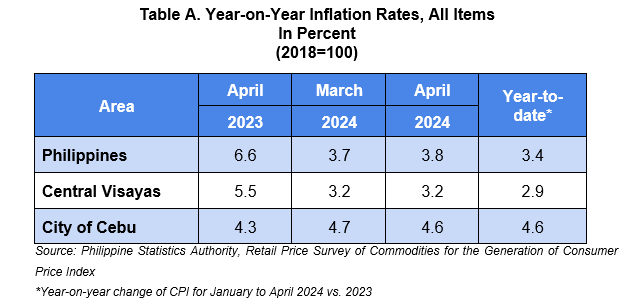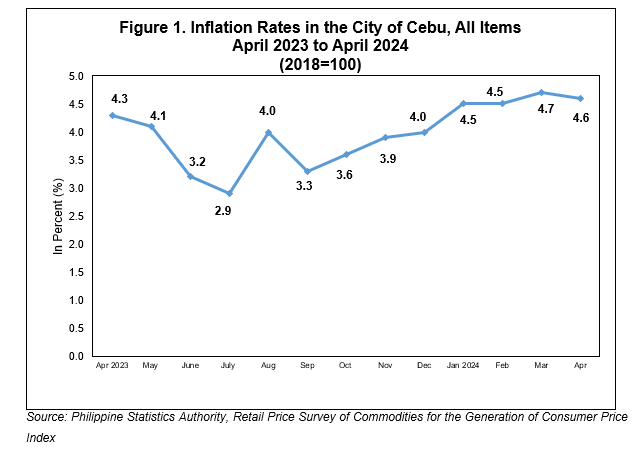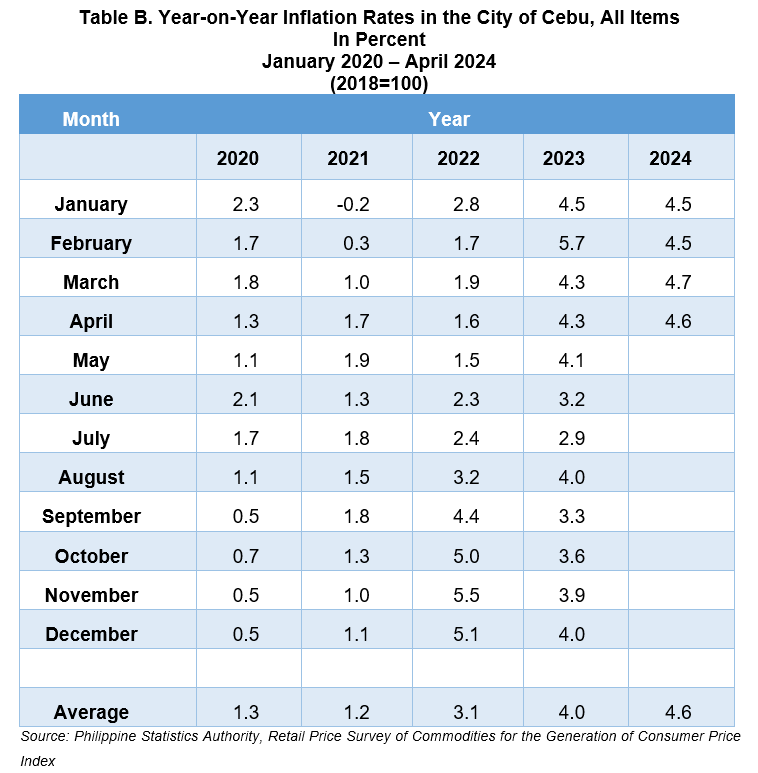Starting February 2022, the Philippine Statistics Authority (PSA) released the rebased Consumer Price Index (CPI) for all income households to base year 2018, from base year 2012 as announced in the press release number 2022-01 dated 04 January 2022. The CPI series for all income households for January 2022 onwards will be 2018-based.


A. The Philippines
The Philippines’ headline inflation or overall inflation increased to 3.8 percent in April 2024 from 3.7 percent in March 2024. This brings the national average inflation from January to April 2024 at 3.4 percent. In April 2023, inflation rate was higher at 6.6 percent. (Table A)
B. Central Visayas
1. Regional Inflation
Central Visayas remained its previous month headline inflation rate at 3.2 percent in April 2024. The regional average inflation rate from January to April 2024 stood at 2.9 percent. In April 2023, the inflation rate in the region was higher at 5.5 percent. (Table A and Figure 1)
C. City of Cebu
1. Headline Inflation
Inflation rate in Cebu City decreased to 4.6 percent in April 2024 from 4.7 percent in March 2024. The city’s average inflation rate from January to April 2024 stood at 4.6 percent. While in April 2023, the inflation rate in the city stood at 4.3 percent. (Table A and Figure 1)
1.1 Main Drivers to the Downward Trend of the Headline Inflation
The downtrend in the city’s headline inflation in April 2024 was brought by the slower annual increase in the heavily-weighted food and non-alcoholic beverages at 6.2 percent during the month from 6.6 percent in March 2024. The slower annual growth rate of the transport index at 4.3 percent in April from 4.9 percent in the previous month also contributed to the downtrend of the headline inflation.
In addition, lower inflation rate were also noted in personal care, and miscellaneous goods and services at 6.0 percent from 6.3 percent in March 2024; and health at 4.9 percent from 5.1 percent in March 2024.
On the contrary, the following commodity groups recorded higher inflation rate during the month:
a. Clothing and footwear, 2.4 percent from 2.0 percent;
b. Housing, water, electricity, gas and other fuels, 4.4 percent from 3.9 percent; and
c. Information and communication, 0.7 percent from 0.0 percent. (Table 3)
Moreover, the indices of the following commodity groups retained their previous month’s annual growth rates:
a. Alcoholic beverages and tobacco, 9.1 percent;
b. Furnishings, household equipment and routine household maintenance, 1.7 percent;
c. Recreation, sport and culture, 10.1 percent;
d. Education services, 2.3 percent;
e. Restaurants and accommodation services, 1.8 percent; and
f. Financial services, -0.3 percent. (Table 3)
1.2 Main Contributors to the Headline Inflation
The top three commodity groups contributing to the April 2024 headline inflation were the following:
a. Food and non-alcoholic beverages with 44.6 percent share or 2.0 percentage points;
b. Housing, water, electricity, gas and other fuels with 25.0 percent share or 1.1 percentage point; and
c. Transport with 7.4 percent share or 0.3 percentage point.
2. Food Inflation
Similar to the headline inflation, food inflation at the city level decelerated to 6.5 percent in April 2024 from 6.9 percent in March 2024. In April 2023, food inflation stood still at 6.5 percent. (Table 7)
2.1 Main Drivers to the Downward Trend of Food Inflation
The deceleration of food inflation in April 2024 was mainly brought by the slower year-on-year increase in fish and other seafood index at 3.8 percent during the month from 7.6 percent in March 2024. Milk, other dairy products and eggs index also recorded a slower increase with an inflation rate of 7.2 percent in April 2024 from 9.6 percent in the previous month, and fruits and nuts at 15.3 percent during the month from 16.1 percent in the previous month.
The index of meat and other parts of slaughtered land animals recorded a faster annual decrease of 2.0 percent during the month from a 0.3 percent annual increase in March 2024 while faster annual decrease of 1.7 percent was observed in sugar, confectionery and desserts index from a 0.4 percent annual decline in March 2024.
In addition, flour, bread and other bakery products, pasta products, and other cereals recorded slower annual increase at 4.2 percent during the month from 4.6 percent in March 2024.
On the other hand, higher inflation rates were observed in the following food groups:
a. Rice, 21.1 percent from 20.5 percent;
b. Corn, -7.4 percent from -9.0 percent;
c. Vegetables, tubers, plantains, cooking bananas and pulses, 3.9 percent from -10.3 percent; and
d. Ready-made food and other food products n.e.c., 9.0 percent from 6.9 percent. (Table 5)
Moreover, oils and fats food group retained its previous month’s inflation rate at -2.1 percent. (Table 5)
2.2 Main Contributors to the Food Inflation
Food inflation shared 42.4 percent or 1.9 percentage points to the overall inflation in April 2024. The top three food groups in terms of contribution to the food inflation during the month were the following:
a. Cereals and cereals products, which includes rice, corn, flour, bread and other bakery products, pasta products, and other cereals, with 72.1 percent share or 4.7 percentage points;
b. Fruits and nuts, with 9.8 percent share or 0.6 percentage points; and
c. Milk, other dairy products and eggs, with 9.7 percent share or 0.6 percentage points.

TECHNICAL NOTES
The Philippine Statistics Authority generates and announces the monthly Consumer Price Index (CPI) based on a nationwide survey of prices for a given basket of goods and services. Two important indicators, the inflation rate and purchasing power of the peso (PPP), are derived from the CPI which are important in monitoring price stability and the value of the country’s currency.
The CPI is an indicator of the change in the average retail prices of a fixed basket of goods and services commonly purchased by households relative to a base year.
Retail Price is the price at which a commodity is sold for spot in small quantities for consumption.
Base Period/Base Year is the period, usually a year, at which the index number is set to 100. It is the reference point of the index number series.
Market Basket is a term used to refer to a sample of goods and services that are commonly purchased and bought by an average Filipino household.
Weight is a value attached to a commodity or ground of commodities to indicate the relative importance of that commodity or group of commodities in the market basket.
Inflation Rate is equivalent to a decline in the purchasing power of the peso. It is the change in the CPI over a specific period of time (usually a month or a year). That is,

where:
CPI1 - is the CPI in the previous period
CPI2 - is the CPI in the current period
The Purchasing Power of the Peso (PPP) is a measure of the real value of the peso in a given period relative to a chosen reference period. It is computed by getting the reciprocal of the CPI and multiplying the result by 100. That is,

Headline Inflation is the rate of change in the weighted average prices of all goods and services in the CPI basket.
Approved by:
(SGD)MELCHOR B. BAUTISTA
Chief Statistical Specialist

